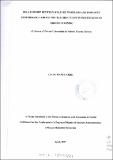| dc.description.abstract | Employee welfare is about the well-being of an employee at work and at home. In the workplace, employee welfare programs aim at improving job satisfaction as a mechanism of improving engagement and commitment at work. This is expected to increase productivity, reduce turnover and enhance loyalty. This study aimed at establishing the relationship between welfare programs and employee performance among non-teaching staff in institutions of higher learning in Kenya. The study focused on how compensation, safety and health, pension and retirement schemes, financial interventions and career growth strategies contributed to employee performance. The study adopted descriptive research design that employed survey methods. The population comprised staff from five private universities in Nairobi County which have been in operation for ten years or more from which a sample of 30% was selected. Data was obtained from members of staff by means of a self-structured questionnaires. The questionnaire had both open-ended and closed-ended questions. Data was analyzed using descriptive statistics such as the frequency, percentages, mean and standard deviation and presented through frequency tables and charts. Correlation analysis was also conducted. The findings revealed a significant relationship between compensation and employee performance. Various components of compensation assessed in the instrument concluded that employee performance commensurate performance. Organizational safety and health had a positive and significant effect on employee performance. It was evident that institutions provided adequate medical insurance to employees, adequate healthcare facilities were available, clean washroom facilities, clean and safe drinking water, adequate security for staff and equipment, provision of firefighting equipment's as well as provision of sports facilities. Pension and Retirement schemes offered by institutions clearly indicated that pension scheme reduced worry about one's family security since a pension and retirement scheme is available for all employees which in turn gives a feeling of power by having some control over planning for retirement. On financial interventions offered by institutions, it was evident that most institutions had a staff Sacco that offered staff investment avenue, provided loans, which were guaranteed by the institution. Salary advance was also available where most respondents felt that this was an effective way of financial intervention hence providing a sense of financial security. Finally, on career growth strategies offered by institutions, there was a small relationship on employee performance. The study concludes that welfare programs for the employees have positive effect on employee performance. The study recommends that organizations should implement welfare programs to motivate employees towards improved performance. | en_US |

